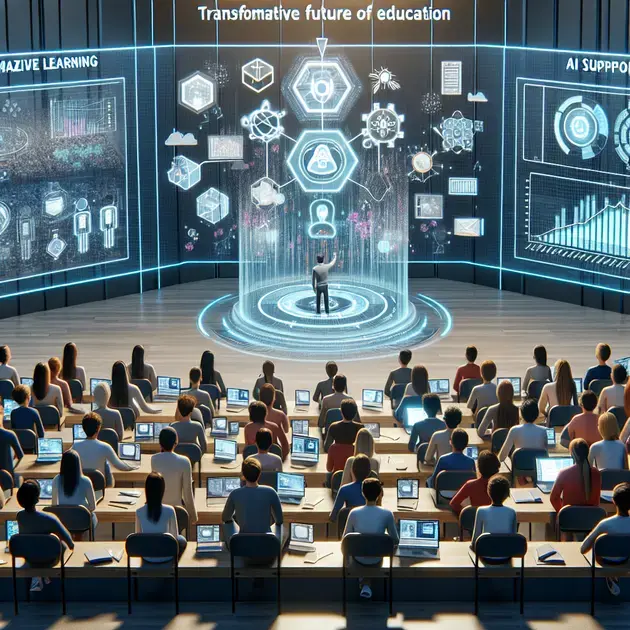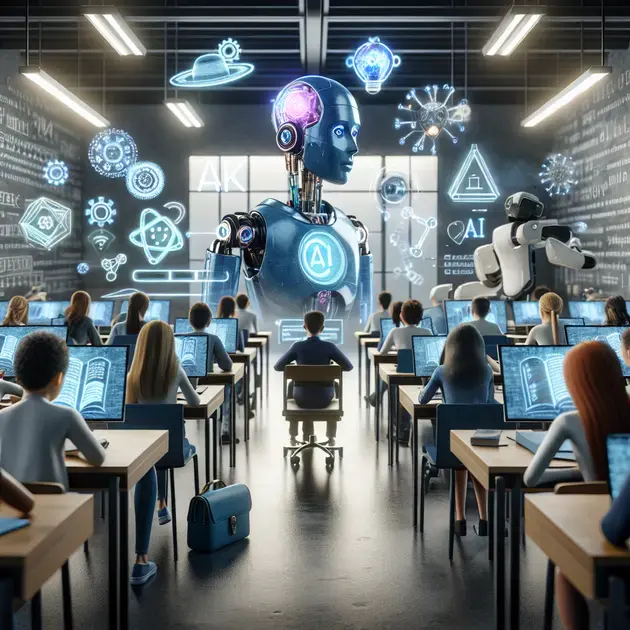Artificial intelligence (AI) has been revolutionizing various industries, and education is no exception. With the advancements in AI technology, educators are finding new ways to enhance the learning experience for students. By incorporating AI tools and algorithms into educational systems, the potential for transforming traditional teaching methods is immense.
One of the key benefits of enhancing education through artificial intelligence is the ability to personalize learning for individual students. AI can analyze data on each student’s learning habits, strengths, and weaknesses to create customized lesson plans. As a result, students can receive targeted support and resources to help them succeed academically.

Enhancing Student Learning with AI Technology
AI technology has revolutionized the way students learn by providing personalized learning experiences. One popular AI-powered platform for students is Squirrel AI Learning, which uses algorithms to analyze individual learning patterns and adapt lesson plans accordingly. To enhance student learning with AI technology, follow these steps:
Step 1: Create a Student Profile on Squirrel AI Learning
Start by creating a student profile on the Squirrel AI Learning website. Enter details such as the student’s grade level, subjects of interest, and areas where they need additional support.
Step 2: Receive Personalized Lesson Plans
Once the student profile is set up, the AI algorithm will generate personalized lesson plans tailored to the student’s needs. These lesson plans may include interactive exercises, quizzes, and educational games.
Step 3: Track Progress and Adjust Learning Path
Monitor the student’s progress on the platform and receive real-time feedback on their performance. Based on this data, the AI technology will adjust the learning path to focus on areas where the student needs improvement.
Step 4: Collaborate with Educators
AI technology also allows educators to track student progress and provide additional support when needed. Teachers can access reports generated by the platform to gain insights into each student’s learning journey.
Step 5: Engage in Continuous Learning
Encourage students to engage in continuous learning through the AI platform by completing daily tasks, participating in virtual classrooms, and seeking help from virtual tutors.
Customized Lesson Plans for Personalized Education
Customized lesson plans play a crucial role in providing personalized education tailored to each student’s unique learning needs. A recommended platform for creating customized lesson plans is Planboard, which offers tools for educators to design individualized learning experiences. Here’s how to create customized lesson plans for personalized education:
Step 1: Sign Up for Planboard
Begin by signing up for an account on the Planboard website. Choose the subscription plan that best suits your needs, whether you’re an individual teacher or part of an educational institution.
Step 2: Define Learning Objectives
Identify the learning objectives and goals for each student based on their academic level, strengths, and areas for improvement. Use the templates provided by Planboard to structure your lesson plans.
Step 3: Incorporate Differentiated Instruction
Customize each student’s learning experience by incorporating differentiated instruction strategies. Use Planboard’s features to create activities, assessments, and resources that cater to diverse learning styles.
Step 4: Monitor Student Progress
Track student progress and performance on Planboard to assess the effectiveness of your customized lesson plans. Make adjustments as needed to ensure that each student is meeting their learning goals.
Step 5: Collaborate with Peers
Collaborate with other educators on Planboard to share lesson plans, resources, and best practices for personalized education. Leverage the platform’s community features to engage in professional development.
AI Support for Academic Success
AI support tools have become invaluable for students seeking academic success by providing personalized assistance and resources. One such AI support tool is Grammarly, which offers grammar checking, plagiarism detection, and writing suggestions to help students improve their academic work. Here’s how to utilize AI support for academic success with Grammarly:
Step 1: Install the Grammarly Extension
Install the Grammarly browser extension or download the Grammarly app on your desktop or mobile device. Create an account to access the full range of AI writing assistance features.
Step 2: Upload Your Academic Work
Upload your essays, research papers, and assignments to Grammarly for a thorough grammar and plagiarism check. The AI technology will provide instant feedback on areas for improvement.
Step 3: Utilize Writing Suggestions
Take advantage of Grammarly’s writing suggestions to enhance the clarity, conciseness, and overall quality of your academic writing. The AI tool offers vocabulary enhancements and tone adjustments to elevate your work.
Step 4: Learn from Mistakes
Review the feedback provided by Grammarly to learn from common mistakes and avoid them in future academic assignments. Use the AI support as a learning tool to improve your writing skills over time.
Step 5: Engage in Peer Review
Collaborate with peers by sharing your Grammarly reports and engaging in peer review sessions. Use the AI support insights to facilitate constructive feedback exchanges and enhance academic success.

Using Artificial Intelligence to Improve Student Engagement
Artificial Intelligence (AI) has the potential to revolutionize the field of education by enhancing student engagement. By leveraging AI technologies, educators can personalize learning experiences, provide real-time feedback, and adapt teaching methods to individual student needs. This personalized approach can significantly increase student motivation and interest in learning, leading to improved academic performance.
One way AI can improve student engagement is through adaptive learning platforms. These platforms use machine learning algorithms to analyze student performance data and adjust the curriculum accordingly. By providing customized learning paths based on each student’s strengths and weaknesses, AI can keep students challenged and engaged at their optimal learning level.
Furthermore, AI-powered chatbots can offer 24/7 support to students, answering questions, providing guidance, and fostering a sense of community within the classroom. This instant access to assistance can help students overcome obstacles more efficiently, keeping them engaged and motivated throughout their learning journey.
Incorporating AI into student engagement strategies also allows for more interactive and immersive learning experiences. Virtual reality simulations, for example, can transport students to different environments and scenarios, making learning more engaging and memorable. By tapping into the power of AI, educators can create dynamic and stimulating educational content that captivates students’ attention.
Overall, utilizing AI to improve student engagement holds immense potential for transforming the educational landscape. By embracing AI technologies and integrating them thoughtfully into classroom practices, educators can create more engaging, personalized, and impactful learning experiences for students.
The Future of Learning: AI in the Classroom
As we look ahead to the future of education, it’s clear that Artificial Intelligence (AI) will play a central role in shaping the classroom of tomorrow. AI technologies have the capacity to revolutionize teaching methods, curriculum development, and student outcomes in ways that were previously unimaginable. By harnessing the power of AI, educators can unlock new possibilities for enhancing the learning experience and preparing students for success in an increasingly digital world.
One key aspect of the future of learning with AI in the classroom is the concept of personalized education. AI algorithms can analyze vast amounts of data to tailor learning experiences to each student’s unique needs, preferences, and learning styles. This individualized approach enables students to learn at their own pace, focus on areas where they need the most support, and maximize their learning potential.
Moreover, AI can facilitate collaboration and communication among students and teachers, breaking down traditional barriers to learning. Virtual classrooms, online discussion forums, and AI-powered assessment tools can foster a more connected and interactive learning environment, where students can engage with course material, peers, and instructors in innovative ways.
Looking forward, AI holds the promise of expanding access to quality education for students around the globe. Through online learning platforms, AI tutors, and interactive content, students in remote or underserved areas can benefit from high-quality educational resources and personalized support. The future of learning with AI is inclusive, diverse, and empowering for learners of all backgrounds.
In conclusion, the integration of AI into the classroom represents a fundamental shift in the way we approach education. By embracing AI technologies and adapting teaching practices to leverage their full potential, educators can create a future where learning is personalized, engaging, and accessible to all.
Implementing AI Tools to Enhance Educational Outcomes
Integrating Artificial Intelligence (AI) tools into educational settings can have a transformative impact on student learning outcomes. By leveraging AI technologies, educators can streamline administrative tasks, gain valuable insights into student performance, and create more engaging and effective teaching strategies. The implementation of AI tools in education opens up new possibilities for personalized learning, data-driven decision-making, and continuous improvement in student outcomes.
One of the key benefits of implementing AI tools in education is the ability to analyze large datasets to identify patterns and trends in student performance. By using predictive analytics, educators can anticipate academic challenges, provide targeted interventions, and support students in achieving their full potential. AI-powered assessment tools can also deliver instant feedback to students, enabling them to track their progress and make timely adjustments to their learning strategies.
Additionally, AI tools can facilitate the creation of adaptive learning environments that cater to individual student needs. Smart content recommendation systems can suggest personalized learning materials based on students’ interests and learning preferences, keeping them engaged and motivated. Virtual tutors and AI-powered learning assistants can provide additional support and guidance, complementing the work of teachers and enriching the educational experience.
By integrating AI tools into educational settings, institutions can enhance the overall quality of education and improve student outcomes. From personalized learning experiences to intelligent tutoring systems, AI technologies offer a wealth of opportunities to optimize teaching and learning processes. Educators who embrace AI tools stand to gain valuable insights, improve student engagement, and drive positive educational outcomes for learners of all ages.
In conclusion, the implementation of AI tools in education represents a significant step towards creating more efficient, effective, and engaging learning environments. By harnessing the power of AI to enhance educational outcomes, educators can empower students to reach their full potential and succeed in an increasingly complex and interconnected world.
Conclusion
The utilization of Artificial Intelligence (AI) in enhancing student engagement presents a transformative opportunity for educators to revolutionize the educational landscape. By integrating AI technologies, educators can personalize learning experiences, provide real-time feedback, and adapt teaching methods to cater to individual student needs. This personalized approach has the potential to significantly boost student motivation, leading to improved academic performance and a more engaging learning environment.
AI-driven adaptive learning platforms play a crucial role in improving student engagement by analyzing performance data and customizing learning paths based on individual strengths and weaknesses. This tailored approach ensures that students remain challenged and engaged at their optimal learning level, resulting in a more effective educational experience.
Furthermore, AI-powered chatbots offering round-the-clock support can enhance student engagement by providing instant assistance, answering queries, and fostering a sense of community within the classroom. By overcoming obstacles efficiently, students can stay motivated and engaged throughout their learning journey, leading to better overall outcomes.